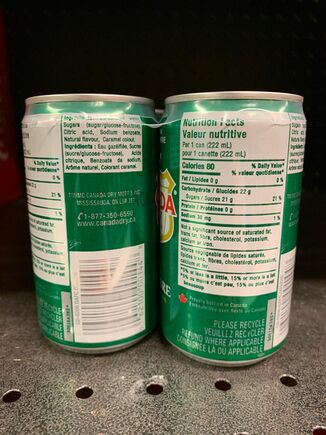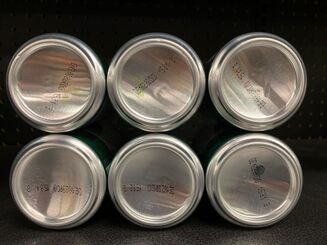Course:FNH200/Assignments/2023/Canada Dry Ginger Ale
Introduction
Ginger ale is a refreshing and effervescent beverage, has long been cherished for its unique and zesty flavour profile. Dating back to the early 19th century, this iconic carbonated drink has managed to capture the hearts of millions around the globe, becoming a beloved classic in the world of soft drinks. Derived from the ginger plant, this concoction offers a delightful blend of sweet and spicy notes, making it a favourite choice for those seeking a thirst-quenching and invigorating experience.






Ingredient Lists
| Ginger Ale | Sugar-Free Ginger Ale | |
|---|---|---|
| Ingredients | carbonated water, sugars (sugar/glucose-fructose), citric acid, sodium benzoate, natural flavour, caramel color | carbonated water, citric acid, sodium citrate, sodium benzoate, malic acid, aspartame (51mg / 222mL; Contains Phenylalanine), acesulfame potassium (21mg / 222mL), natural flavour, caramel colour, calcium disodium EDTA |
| Fat Substitutes | N/A | N/A |
| Sugar Substitutes | N/A | aspartame, acesulfame potassium |
| Additives | sodium benzoate, caramel colour | citric acid, sodium citrate, sodium benzoate, malic acid, caramel colour, calcium disodium edta |
Sugar Substitutes
- *Aspartame is a low-caloric sweetener found in acidified beverages such as ginger ale. It is 180-220 times sweeter than sucrose and therefore very small amounts can be used to yield the same sweetness with low (and in sugar free ginger ale, no,) calories.[1]
- Ascesulfame-K is a non-caloric sweetener used with Aspartame in soft drinks such as ginger ale, to provide a synergistic sweetening effect. It is 200 times sweeter than sucrose and not metabolized by the body, therefore contributing no calories to the soda.[1]
Additives
- Citric acid and Malic acid are used for flavour enhancing purposes. They are permitted for use in Canada in ginger ale, an unstandardized food.[2]
- Sodium citrate is added as a preservative to maintain pH levels. It is permitted for use in Canada as a pH adjusting agent in unstandardized foods, such as ginger ale.[3]
- Sodium benzoate is a class 2 preservative permitted by Health Canada. It functions to prolong the shelf-life of the ginger ale.[4]
- **Caramel Colour is added to ginger ale for aesthetic purposes. Its use is justified by the Food and Agriculture Organization as it makes the soda attractive without deception.[5]
- Calcium disodium EDTA is added as a preservative to protect flavour. It is permitted for use in Canada as a sequestering agent (prevents enzymatic deterioration) in ready-to-drink soft drinks, such as ginger ale.[6]
*Note that Aspartame containing products must state “contains phenylalanine” for individuals with phenylketonuria. This labelling is found underneath the ingredient list on the sugar-free ginger ale can.[1]
**Note that the United States classifies natural flavour as a food additive, but Canada does not.[5]
Labels
| Canada Dry ginger ale regular vs Canada Dry ginger ale zero sugar | |
|---|---|
| Common Name | It is commonly known as Ginger ale and zero sugar Ginger ale |
| Bilingualism | Both products had information in English and French. |
| Net Quantity | The net quantity for both is 222mL |
| Name Of Business | The company's website and number are on the back of the page and the name of the business is displayed on the front of the can as "Canada Dry" |
| Nutritional Label | Both cans display the nutritional label on the back of the can |
| Country of Origin | It states 'proudly bottled in Canada' on the back of the can |
| Date Markings & Storage Instructions | The Best before dates are seen at the bottom of the cans |
| Nutrition Facts | Can be found in image 2 and 5 |
| Irradiation | Not indicated on the label |
| List of Ingredients and Allergens | Found in image 2 and 5, additionally in the 'ingredients list' section above. |
| Sweeteners | Found in image 2 and 5, additionally in the 'ingredients list' section above. |
| Food Additives | Found in image 2 and 5, additionally in the 'ingredients list' section above. |
| Additional Information found on the cans | They are both recyclable and the zero-sugar ginger ale explicitly states that it contains phenylalanine, which is found in aspartame. |
Regulatory Requirements
- As per Section 5 of the Food and Drug Act of Canada, it is clearly stated that "No person shall label, package, treat, process, sell, or advertise any food in a manner that is false." Examining the packaging of regular ginger ale, it prominently claims to contain "100% natural flavours."[7] However, upon closer inspection of the ingredient list, natural flavours are listed as the second last component. This discrepancy raises doubts about the validity of the claim that it is 100% natural.
- Both products appear to adhere to the guidelines outlined in Section 3 and 4 of the Food and Drug Act of Canada. Section 3 states “no person shall advertise any food, drug, cosmetic or device to the general public as a treatment, preventative or cure for any of the diseases, disorders or abnormal physical states”.[7] Similarly Section 4 states “No person shall sell an article of food that:(a) has in or upon it any poisonous or harmful substance; (b) is unfit for human consumption; (c) consists in whole or in part of any filthy, putrid, disgusting, rotten decomposed or diseased animal or vegetable substance; (d) is adulterated; (e) was manufactured, prepared, preserved, packaged or stored under unsanitary conditions”.[7]
- As for section 7 of the food and drug act of Canada, which states “No person shall manufacture, prepare, preserve, package or store for sale any food under unsanitary conditions.”[7] Nothing on the packaging is mentioned regarding its manufacturing.
Comparing List of Ingredients
| Similarities | Differences | |
|---|---|---|
| Carbonated water | ZERO Sugar | Regular |
| Citric Acid | Malic Acid | Sugar/Glucose-Fructose |
| Natural Flavours | Sodium Citrate | |
| Sodium Benzoate | Calcium Disodium EDTA | |
| Caramel Colour | Aspartame (Contains Phenylalanine) | |
| Acesulfame Potassium | ||
- Similarities: There are several common ingredients amongst the zero sugar and the regular ginger ale. Both share the ingredients: carbonated water, citric acid, sodium benzoate and natural flavours. Carbonated water is the main ingredient for both beverages, being first on the ingredient lists. Citric acid helps enhance the flavour and is listed as the third ingredient in the regular version and the second in the zero sugar version. Sodium benzoate, a preservative, is listed after citric acid in both beverages. Natural flavours is listed as the fifth ingredient in the regular and as the eighth ingredient in the zero sugar. Both ginger ales also use caramel colour as a colourant to enhance the appearance, and are listed as the last ingredient on both lists.
- Differences: The main difference between the two beverages are the ingredients used to sweeten the products. We see in the regular ginger ale, the second ingredient is sugar/glucose-fructose. However, zero sugar ginger ale instead uses aspartame (51 mg/222 mL) and acesulfame potassium (21 mg/ 222 mL) as a sugar substitute for sugars. The use of these sugar substitutes reduces the number of carbohydrates in the sugar free version from 21 g (regular) to 0 g per serving, which makes the beverage "zero sugar". Since aspartame is used, the ingredient label states to contain phenylalanine. Other ingredients included in the zero sugar ginger ale and are not present in the regular ginger ale include: malic acid, sodium citrate, and calcium disodium EDTA. Malic acid is used to enhance the flavour, where as calcium disodium EDTA and sodium citrate are additional preservatives which help prolong the shelf life of zero sugar ginger ale.
References
- ↑ 1.0 1.1 1.2 "3.1.2 Types of Sugar Substitutes - Sweeteners". FNH 200 UBC Canvas. Retrieved July 15, 2023.
- ↑ "Food and Drugs Regulations". Government of Canada. February 15, 2023. Retrieved July 15, 2023.
- ↑ "Sodium Citrate". The Chemical Company. Retrieved July 15, 2023.
- ↑ "11. List of Permitted Preservatives (Lists of Permitted Food Additives)". Government of Canada. August 8, 2022. Retrieved July 15, 2023.
- ↑ 5.0 5.1 "4.7 Food Additives". FNH 200 UBC Canvas. Retrieved July 16, 2023.
- ↑ "Chelate". Britannica. September 5, 2007. Retrieved July 15, 2023.
- ↑ 7.0 7.1 7.2 7.3 "Food and Drug Act". Government of Canada. June 13, 2023. Retrieved July 16, 2023.
| This Food Science resource was created by Course:FNH200. |
